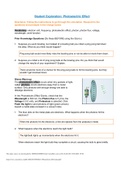Exam (elaborations)
SCH4U1 - Photoelectric Effect Questions And Answers 100% Graded A+
- Course
- Institution
Student Exploration: Photoelectric Effect Directions: Follow the instructions to go through the simulation. Respond to the questions and prompts in the orange boxes. Vocabulary: electron volt, frequency, photoelectric effect, photon, photon flux, voltage, wavelength, work function Prior Knowle...
[Show more]



